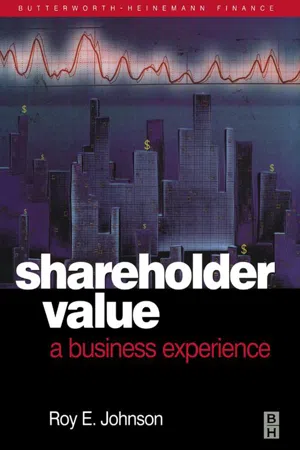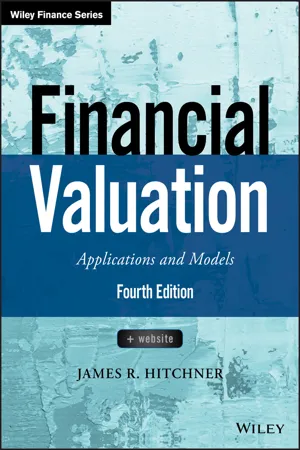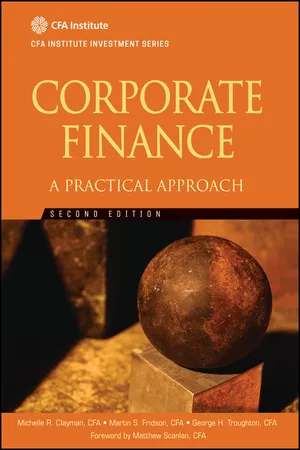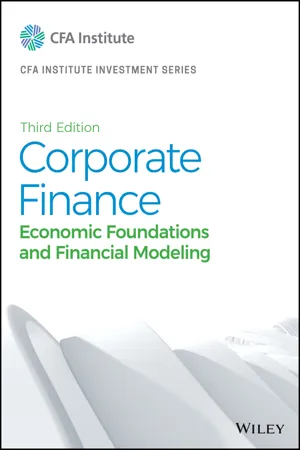Business
Cost of Equity Capital
Cost of equity capital refers to the return that a company is expected to generate for its shareholders. It represents the compensation demanded by investors for bearing the risk of owning a company's stock. This cost is used in financial valuation models to determine the required rate of return for equity investors.
Written by Perlego with AI-assistance
Related key terms
1 of 5
10 Key excerpts on "Cost of Equity Capital"
- eBook - PDF
- E. Porras(Author)
- 2010(Publication Date)
- Palgrave Macmillan(Publisher)
6 1 A General Introduction to Risk, Return, and the Cost of Capital The relevance of the cost of capital The cost of capital to a firm is the return 1 investors receive on their investments. Therefore, in this context, an investor is anyone who lends money to a firm or agency in exchange for some ‘profit’. The providing of funds to the firm could be done by purchasing some of the company’s common stock, bonds, 2 or in a number of additional ways we shall comment on later. The higher the profit desired by the investor, the greater the cost to the firm or paying agency. One reason why firms calculate their cost of capital is to determine a mini- mum discount rate 3 to use when evaluating proposed capital expenditure projects. The purpose of capital expenditure analysis is to decide which, if any, of a list of planned projects, the firm should actually undertake. It is then logical that the cost of capital to be estimated and compared with the expected benefits from the proposed projects is equated with the marginal cost of capital the firm raises (the price of acquiring the next dollar, pound, yen or euro ...), not a historical-cost estimate. This is because firms must incorporate the real costs into their calculations when capital is going to be raised, and past histori- cal information is of no use for this purpose. If the marginal cost of capital is too high, the firm might find out none of its list of proposed projects is capable of returning sufficient profit to cover that cost. For example, let us say you want to open a photocopying business. This project is going to be financed exclusively with equity 4 and, considering the return that could be made on equivalent investments, your shareholders want a 35 per cent return. If all you can expect to make with this project is 10 per cent on each dollar invested, you could not afford to repay what your investors demand. - eBook - ePub
- RoyE. Johnson(Author)
- 2001(Publication Date)
- Butterworth-Heinemann(Publisher)
Jason, unaware of what was going in Jack’s mind, continued … “Common stocks have a wide range of returns with respect to individual companies, since there are thousands that are publicly owned and traded. Overall, stocks have produced an annual rate of return over the past sixty or so years that has averaged approximately five percentage points higher than the return for government bonds. This is the ‘reward’ that equity investors have experienced (and enjoyed) by holding on to their stocks. This is called the ‘market risk premium’. Why do we use this term? The reason is that the experience of the ‘market’ has become a requirement for managers who have been entrusted with equity capital. This is an important point, and I plan to discuss it in more depth shortly”.“If we take all the points on this ‘stock market theory’ chart (Exhibit 10 ), we can construct the following formula to calculate the Cost of Equity Capital for the overall stock market:Cost of Equity equals the risk − free rate plus the market riskpremium .In our example, at the bottom of Exhibit 10 , based on a government bond rate in the range of 6.5%, the return for the overall stock market is approximately 11.5%. This is the annual rate of return an investor would expect from an ‘indexed’ mutual fund, which represents a broad stock market average such as the Standard & Poor’s (S&P) 500”.“OK, so far so good and not controversial”, Jill interjected, realizing that it had been quite a while since she had spoken. “But, what about Jack’s earlier comment about ‘beta’?”“We’re just about there”, Jason responded. While Jason spoke, Jack sat up and again placed his arms on the top of the conference table, thinking to himself … “maybe this will be interesting ” … and also thinking how much he liked to have his direct reports either responding positively to or supporting his positions.Jason, moving ahead on his own agenda, continued … “The controversy comes in calculating an individual firm’s risk, or ‘beta’. So, what we’re talking about is the accuracy of the Cost of Equity Capital calculation for a company. We’ve established that equity capital is the most expensive form of capital, which is why we need to include it in any evaluation of management performance or in the analysis of a business strategy, new business venture or acquisition. This is what Earl, Frank and I were talking about this morning when we said that the Cost of Equity Capital is important. This morning, we focused on the fact that this cost is not readily apparent in our financial statements; in essence, it is ‘hidden’. Now this situation is compounded by the fact that the Cost of Equity Capital is clearly the ‘most expensive’, regardless of its actual cost. The argument centers on the ‘beta’ statistic being an accurate measure of the volatility for the stock price of an individual company versus the ‘market’ – the ‘market’ having a ‘beta’ of 1.0. Thus, the debate boils down to whether the company specific risk is, for example, 0.8 or 1.2. By working through the formula in the example on the screen (Exhibit 10 - eBook - PDF
The Cost of Capital
Theory and Estimation
- Cleveland S. Patterson(Author)
- 1995(Publication Date)
- Praeger(Publisher)
2 Theoretical Models for Estimating the Cost of Equity Capital In this chapter, we take the business risks and financial risks of a firm as given and look at several models for estimating k e , the equity investors' required rate of return, or opportunity cost of common equity capital. I. MODEL CLASSIFICATION The models that have been developed in the academic literature and/or that are used in practice to estimate k e can be classified into a number of categories according to their underlying logic and assumptions. These are summarized in Figure 2.1. On the left-hand side are a variety of accounting-based approaches that use historical averages of a firm's own earned returns as indicators of required returns on common equity or, more commonly, employ average ac- counting returns for groups of firms considered to have a similar degree of risk. The latter approach, usually referred to under the rubric of "comparable earn- ings," has been widely used over many years in public utility regulatory hear- ings. As discussed in Chapter 6, this method has the trappings of an opportu- nity cost in the sense of looking to the earnings of alternative investments but suffers seriously from a variety of theoretical and practical difficulties. The opportunity cost of capital, properly defined, relates to opportunities available to investors in capital markets. The right-hand branch of Figure 2.1 20 The Cost of Capital Figure 2.1 Classification of Cost of Capital Models shows several methods grounded in this concept. It is useful to classify them into two groups, which complement each other. First are those models, labeled "explicit," which build up an estimate of k e from separately estimated compo- nents chosen according to a given theory of equilibrium pricing in capital mar- kets. Generally, these models take the form of combining an estimate of the observed risk-free rate (NRFR) with one or more risk premiums based on the underlying theory. - eBook - ePub
Corporate Valuation
Measuring the Value of Companies in Turbulent Times
- Mario Massari, Gianfranco Gianfrate, Laura Zanetti(Authors)
- 2016(Publication Date)
- Wiley(Publisher)
Chapter 8 Estimating the Cost of Capital8.1 DEFINING THE OPPORTUNITY COST OF CAPITAL
In the previous Chapters we have discussed the calculation of the proper discount rate for cash flows by introducing formulas that are consistent with the asset and equity side standpoints and with the different definitions and derivations of the tax benefits associated with debt. All these formulas stem from two basic parameters referred to as the opportunity cost of capital of a firm with no debt ( ) and the opportunity cost of debt ( ).measures the rate of return that is considered acceptable by investors in the equity of a firm with no debt. The return should reflect only the risk profile associated with corporate assets regardless of the financial structure. As we are dealing with an opportunity cost, this return should be estimated taking into account the alternative returns that could be obtained from other investments characterized by similar risk profiles.On the other hand, measures (again, as an opportunity cost) the rate of return that is deemed acceptable by the holders of the firm debt. The risk for the underwriters of corporate financial liabilities is mostly a function of the likelihood of the firm not being able to timely fulfill its obligations along the agreed debt service schedule.8.2 A FEW COMMENTS ON RISK
For economists, risky situations are usually associated with cases in which an “objective” probability (i.e., based on meaningful retrospective observations) can be attributed to a range of possible events. “Uncertain” situations, on the other hand, are characterized by the apparent inability to attribute an objective probability to a certain event.Following the general practice, going forward we will use the terms risk and uncertainty - No longer available |Learn more
Financial Valuation
Applications and Models
- James R. Hitchner(Author)
- 2017(Publication Date)
- Wiley(Publisher)
Often a business enterprise—particularly in the small and midsize markets—is focused on the benefit stream and growth potential variables, while too often the risk is left to chance. Assuming no change in the first two variables, reducing the risk attributes of a business will increase its value. 186 FINANCIAL VALUATION The cost of capital is also referred to as the discount rate. It equals the total expected rate of return for the investment—that is, dividends or withdrawals, plus expected capital appreciation over the life of the investment. This rate can be applied to the appropriate income or cash flow stream of a company to estimate the company’s present value. ValTip Identifying the value drivers of an enterprise and developing action steps to limit or reduce controllable (e.g., internally oriented versus external) risks can be of great benefit to many closely held businesses in terms of increasing their value. The value of a company can be expressed as the present value of the future economic benefits expected to be generated by the company. This value can be either for equity, in which case the future benefits are those directly to equity and an equity discount rate must be used, or for the overall company, including its debt, in which case a weighted average cost of capital (WACC) must be used. ValTip The cost of capital reflects investors’ return expectations, which are essentially composed of a risk-free rate and a risk premium: 1 ■ The risk-free rate captures a rental rate, inflation, and maturity risk. The rental rate represents a real return for lending funds free of default risk and forgoing current consumption. Inflation and inflation risk represent expected inflation and the risk that expected inflation will increase. Maturity risk represents the risk that the investment’s principal market value will change during the period to maturity as a function of changes in interest rates. - eBook - ePub
Corporate Finance
A Practical Approach
- Michelle R. Clayman, Martin S. Fridson, George H. Troughton(Authors)
- 2012(Publication Date)
- Wiley(Publisher)
- The dividend discount model approach is an alternative approach to calculating the cost of equity, whereby the cost of equity is estimated as follows:
- We can estimate the growth rate in the dividend discount model by using published forecasts of analysts or by estimating the sustainable growth rate:
- In estimating the cost of equity, an alternative to the CAPM and dividend discount approaches is the bond yield plus risk premium approach. In this approach, we estimate the before-tax cost of debt and add a risk premium that reflects the additional risk associated with the company’s equity.
- The marginal cost of capital schedule is a graph plotting the new funds raised by a company on the x -axis and the cost of capital on the y -axis. The cost of capital is level to the point at which one of the costs of capital changes, such as when the company bumps up against a debt covenant, requiring it to use another form of capital. We calculate a break point using information on when the different sources’ costs change and the proportions that the company uses when it raises additional capital:
- Flotation costs are costs incurred in the process of raising additional capital. The preferred method of including these costs in the analysis is as an initial cash flow in the valuation analysis.
- Survey evidence tells us that the CAPM method is the most popular method used by companies in estimating the cost of equity. The CAPM is more popular with larger, publicly traded companies, which is understandable considering the additional analyses and assumptions required in estimating systematic risk for a private company or project.
PROBLEMS1. The cost of equity is equal to the: A. expected market return. B. rate of return required by stockholders. C. cost of retained earnings plus dividends. 2. Which of the following statements is correct? - eBook - PDF
Corporate Finance
Economic Foundations and Financial Modeling
- Michelle R. Clayman, Martin S. Fridson, George H. Troughton, Michelle R. Clayman, Martin S. Fridson, George H. Troughton(Authors)
- 2022(Publication Date)
- Wiley(Publisher)
CHAPTER 8 COST OF CAPITAL: ADVANCED TOPICS Lee M. Dunham, PhD, CFA Creighton University (USA) Pamela Peterson Drake, PhD, CFA James Madison University (USA) LEARNING OUTCOMES The candidate should be able to: • explain top-down and bottom-up factors that impact the cost of capital • compare methods used to estimate the cost of debt • explain historical and forward-looking approaches to estimating an equity risk premium • compare methods used to estimate the required return on equity • estimate the cost of debt or required return on equity for a public company and a private company • evaluate a company’s capital structure and cost of capital relative to peers 1. INTRODUCTION A company’s weighted average cost of capital (WACC) represents the cost of debt and equity capital used by the company to finance its assets. The cost of debt is the after-tax cost to the issuer of debt, based on the return that debt investors require to finance a company. The cost of equity represents the return that equity investors require to own a company, also referred to as the required rate of return on equity or the required return on equity. A company’s WACC is used by the company’s internal decision makers to evaluate capital investments. For analysts and investors, it is a critical input used in company valuation. Equation 1 reminds us that a company’s WACC is driven by the proportions, or weights (the w i Þ, of the different capital sources used in its capital structure, applied to the costs of 249 each source (the r i ), with d, p, and e subscripts denoting debt, preferred equity, and common equity, respectively: WACC ¼ w d r d (1 – t) þ w p r p þ w e r e . (1) (These weights are all non-negative and sum to 1.0.) Determining a company’s WACC is an important, albeit challenging, task for an analyst given the following: • Many different methods can be used to calculate the costs of each source of capital; there is no single, “right” method. - eBook - ePub
- Michael Dempsey(Author)
- 2017(Publication Date)
- WSPC (EUROPE)(Publisher)
Chapter 6
Shareholders’ Required Rate of Return (The Cost of Equity Capital)
In this country, you gotta make the money first. Then when you get the money, you get the power. Then when you get the power, then you get the women.Tony MontanaThere is no unique picture of reality.Stephen HawkingHistory may not repeat itself, but it does rhyme a lot.Mark TwainEverybody’s got good luck, everybody’s got bad luck. But you got to be there for the turns.Gordon GekkoMain Course Menu(to be digested slowly)The contents of this chapter are designed so that the student will be able to(1) Interpret the capital asset pricing model (CAPM) that was introduced in Chapter 1 — both as a model of the firm’s required rate of return and (as the name of the model suggests) a model of capital asset pricing.(2) Understand how the CAPM implies the security market line (SML) as a linear relation between investors’ required rate of return on an asset and that asset’s beta (β).(3) Understand how beta (β) is likely to be measured in practice.(4) Recognize that — even if we accept the CAPM as a model for the firm’s Cost of Equity Capital — the practical difficulty in estimating the parameters in the CAPM — the risk-free rate, beta, and the market risk premium — implies that the Cost of Equity Capital remains a “nebulous” number.(5) Interpret the formal tests of the CAPM in relation to historical data and recognize how the tests actually contradict the CAPM as a meaningful description of share price formation. (6) Understand the possible reasons why the CAPM — which appears entirely reasonable as a model of investor rationality — is not reflected in the historical data of share prices.(7) Critique the Fama and French three-factor model as an advancement on the CAPM. In addition to the market risk premium, the model proposes additional return premiums for investing in (i) stocks of small size companies and (ii) stocks of companies with a high ratio of book equity to market equity. The student will recognize that the model is based on a “data mining” exercise of past share price movements and lacks a convincing justification in terms of a risk–return relation. - eBook - PDF
- Robert Parrino, David S. Kidwell, Thomas Bates, Stuart L. Gillan(Authors)
- 2021(Publication Date)
- Wiley(Publisher)
This is the appropriate opportunity Cost of Equity Capital for an NPV analysis if the project has the same risk as the firm and will have similar leverage. Furthermore, CAPM does not require financial analysts to make assumptions about future growth rates in dividends, as Methods 2 and 3 do. Used properly, Methods 2 and 3 provide an estimate of the rate of return that is implied by the current price of a firm’s stock at a particular point in time. If the stock markets are efficient, then this should be the same as the number that we would estimate using CAPM. However, to the extent that the firm’s stock is mispriced—for example, because investors are not informed or have misinterpreted the future prospects for the firm—deriving the cost of equity from the price at one point in time can yield a bad estimate of the true cost of equity. Preferred Stock As we discussed in Chapter 9, preferred stock is a form of equity that has a stated value and specified dividend rate. For example, a share of preferred stock might have a stated value of $100 and a 5 percent dividend rate. The owner of such a share would be entitled to receive a dividend of $5 ($100 × 0.05 = $5) each year. Another key feature of preferred stock is that it does not have an expiration date. In other words, preferred stock continues to pay the specified dividend in perpetuity, unless the firm repurchases it or goes out of business. These characteristics of preferred stock allow us to use the perpetuity model, Equation 6.4, to estimate the cost of preferred equity. For example, suppose that investors would pay $85 for a share of the preferred stock mentioned above. We can rewrite Equation 6.4: PVP = CF _ i as: P ps = D ps _ k ps where P ps is the present value of the expected dividends (the current preferred stock price), D ps is the annual preferred stock dividend, and k ps is the cost of the preferred stock. - eBook - PDF
- Robert Parrino, David S. Kidwell, Thomas Bates(Authors)
- 2016(Publication Date)
- Wiley(Publisher)
In this example, you can directly compare the pre-tax costs of the two alternatives. You do not need to calculate the after-tax costs because multiplying each pre-tax cost by the same number, − t 1 , will not change your decision. Before You Go On 1. Why do analysts care about the current cost of long-term debt when estimating a firm’s cost of capital? 2. How do you estimate the cost of debt for a firm with more than one type of debt? 3. How do taxes affect the cost of debt? THE COST OF CAPITAL 446 the cost of ordinary shares. It is important to remember throughout this discussion that the ‘cost’ we are referring to is the rate of return that investors require for investing in the shares at a par-ticular point in time, given their systematic risk. Method 1: Using the Capital Asset Pricing Model (CAPM) The first method for estimating the cost of ordinary shares is one that we discussed in Chapter 7. This method uses Equation 7.9: [ ] = + − E R R E R R ( ) ( ) i i rf m rf b In this equation, the expected return on an asset is a linear function of the systematic risk associ-ated with that asset. If we recognise that E R ( ) i in Equation 7.9 is the cost of the ordinary share capital used by the firm k ( ) os when we are calculating the cost of equity and that [ ] − E R R ( ) m rf is the market risk premium, we can rewrite Equation 7.9 as follows: k R Market risk premium os rf os b ) ( = + × (13.4) Equation 13.4 is just another way of writing Equation 7.9. It tells us that the cost of ordinary shares equals the risk-free rate of return plus compensation for the systematic risk associated with the ordinary shares. You already saw some examples of how to use this equation to calcu-late the cost of equity in the discussion of the Capital Asset Pricing Model (CAPM) in Chapter 7. In those examples, you were given the current risk-free rate, the beta for the shares and the mar-ket risk premium and were asked to calculate k os using the equation.
Index pages curate the most relevant extracts from our library of academic textbooks. They’ve been created using an in-house natural language model (NLM), each adding context and meaning to key research topics.









